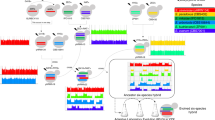Abstract
STUDYING the modification of a large number of experimentally produced polyploid plants of various species and families (Solanaceæ, Gramineæ, Compositæ, etc.) within the single plants and in the polyploid lines in respect to the modification of their diploid forms, when the plants grew in equal environmental conditions, I found the following regularities. Cell dimensions showed in the majority of the cases studied a greater modification in the tetraploid than in the diploid plants. Cell dimensions of the experimentally produced octoploids were more variable than the cell dimensions of tetraploid and diploid forms. The numbers of chloroplasts per pair of stomatal cells were more variable in the tetraploids than in the diploids and much more variable in the octoploids than in the tetraploids and diploids. Counting, for example, the chloroplasts1 in 100 pairs of stomatal cells of each form of Nicotiana alata—diploid, tetraploid and octoploid, the following values for the standard deviations were respectively found: σ2n = 1·81, σ4n = 4·70, and σ8n = 7·03. (It was found that polyploidy does not affect the size of the chloroplasts1 2. It also does not significantly affect the variability of the chloroplast diameter.) The modification of the cell dimensions decreases somewhat gradually in the subsequent polyploid generations, that is, it decreases with the increase of the polyploid generations. But in the cases studied tetraploids still had more variable cell dimensions in the fifth generation than the corresponding diploids.
This is a preview of subscription content, access via your institution
Access options
Subscribe to this journal
Receive 51 print issues and online access
$199.00 per year
only $3.90 per issue
Buy this article
- Purchase on Springer Link
- Instant access to full article PDF
Prices may be subject to local taxes which are calculated during checkout
Similar content being viewed by others
References
Cf. Kostoff, D., Curr. Sci., 7, 270â273 (1938).
Kostoff, D., and Orlov, A., Ann. Bot., 2, 883â886 (1938).
Kostoff, D., NATURE, 144, 599, (1939).
Kostoff, D., Curr. Sci., 3, 302â304 (1935).
Kostoff, D., and Kendall, J., Gartenbauwiss., 9, 20â44 (1934).
Kostoff, D., J. Genet., 37, 129â209 (1938).
Author information
Authors and Affiliations
Rights and permissions
About this article
Cite this article
KOSTOFF, D. Polyploids are More Variable than their Original Diploids. Nature 144, 868–869 (1939). https://doi.org/10.1038/144868b0
Issue Date:
DOI: https://doi.org/10.1038/144868b0
This article is cited by
-
Cytogenetical studies of two amphidiploids in the genus Oryza
Euphytica (1964)
-
Biometrical variation in flowers of a polyploid series of strawberries
Journal of Genetics (1954)
-
Cytology of cereals. II
The Botanical Review (1946)
-
Untersuchungen über den osmotischen Wert polyploider Pflanzen
Planta (1941)
Comments
By submitting a comment you agree to abide by our Terms and Community Guidelines. If you find something abusive or that does not comply with our terms or guidelines please flag it as inappropriate.



